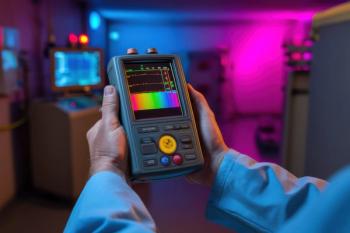
Using UV-vis Spectroscopy for Fast, Affordable Diagnosis of Post-Covid Conditions
Key Takeaways
- UV-vis spectroscopy offers a rapid, non-invasive, and cost-effective alternative to traditional lipidomics and proteomics for assessing post-Covid-19 symptoms.
- The study found significant spectral variability in the UV-vis range correlating with symptom severity and clinical features, such as hospitalization and oxygen therapy.
Researchers at Santiago de Compostela University (Santiago, Spain) find ultraviolet–visible (UV–vis) spectroscopy can detect and quantify post-COVID condition with high accuracy, paving the way for real-time clinical use.
A recent study explored how spectroscopy can play a role in assessing the severity of post-Covid-19 (also known as long Covid) symptoms. This study, which was published in the journal Spectrochimica Acta Part A: Molecular and Biomolecular Spectroscopy, was led by researchers from Santiago de Compostela University in Spain, and it profiled the benefits of using ultraviolet–visible (UV-vis) spectroscopy, which include being rapid, non-invasive, and cost-effective, instead of traditional methods.
What is the severity of post-Covid conditions?
Although the Covid-19 pandemic is over, the disease can still spread from human to human. Post-Covid conditions are defined as chronic conditions that originated from contracting the virus (2). Some of the most common symptoms of long Covid include issues with taste and smell, brain fog, and extreme tiredness. Those inflicted with long Covid also experience sleeping issues, consistent headaches, and potential digestion problems (2). Many long Covid cases last over a year (1).
Currently, traditional diagnostic approaches rely heavily on lipidomics and proteomics. Both methods are effective, but they are time-consuming and expensive (1). These methods require specialized equipment, trained personnel, and significant processing time, limiting their accessibility and scalability (1).
What did the researchers attempt to do in their study?
The researchers conducted a study to test the effectiveness of UV-vis spectroscopy to capture information about a patient’s symptoms through blood samples. In their study, the researchers analyzed blood samples from 130 individuals with post-Covid conditions, 65 of whom had been previously studied using proteomics and lipidomics (1). The purpose was to determine whether spectroscopic techniques could capture meaningful information about a patient’s symptoms and disease severity (1).
The study focused on the supernatant fraction of blood and found that the spectral range between 297 and 600 nanometers in the UV–vis region held the most diagnostically relevant information. In this window, the researchers observed significant spectral variability that strongly correlated with whether patients were symptomatic or asymptomatic (1). Notably, these variations also aligned with key clinical features, such as whether a patient had been hospitalized or required oxygen therapy during their acute infection (1).
The researchers then evaluated these spectral differences. Using unsupervised clustering algorithms, the researchers grouped patients according to symptom severity. When these groupings were compared to classifications based on clinical symptom reports, the match was strong, achieving a Jaccard similarity score of 0.667 (1). This outcome underscores the method’s ability to mirror real-world clinical observations using only spectrophotometric data.
Moreover, comparisons with the existing proteomic and lipidomic data sets from the same patients revealed moderate to strong concordance, affirming that spectroscopic analysis captures similar biochemical changes (1). Although spectroscopy may not deliver the molecular granularity of omics techniques, it provides a holistic snapshot of the blood’s biochemical state (1).
What makes this method better than omics methods?
Using spectroscopy is better than omics methods because it is rapid and computationally lightweight (1). Spectroscopy is also a much more efficient method because they require intricate sample preparation and massive data processing (1). This efficiency opens the door to developing portable or point-of-care (POC) devices capable of real-time post-Covid condition assessments in clinics or even at home (1).
That being said, the authors acknowledge that more work is needed on their method. Because their sample size was 130 patients, the researchers suggest future studies should expand sampling to include more diverse populations. Moreover, future iterations could benefit from expanding the spectral range and incorporating advanced machine learning algorithms to improve classification accuracy and overcome potential misclassifications due to overlapping spectral features (1).
What are the implications of this study?
Based on the results achieved in this study, the researchers showed that UV-vis spectroscopy can become a valuable complement or alternative to conventional omics-based diagnostics for Long Covid. Because of its affordability, speed, and adaptability, UV-vis is positioned to take on a more active role in healthcare, including assessing symptoms patients are experiencing (1).
Despite herd immunity being reached, this does not mean that there aren’t those who struggle with lingering Covid-19 symptoms. With further development, spectroscopic diagnostics could become a vital tool to combat the lingering effects of Covid-19.
References
- Antelo-Riveiro, P.; Vazquez, M.; Dominguez-Santalla, M. J.; et al. Rapid Diagnosis and Severity Scale of Post-COVID Condition Using Advanced Spectroscopy. Spectrochimica Acta Part A: Mol. Biomol. Spectrosc. 2025, 328, 125474. DOI:
10.1016/j.saa.2024.125474 - Mayo Clinic Staff, Long COVID: Lasting Effects of COVID-19. Mayo Clinic. Available at:
https://www.mayoclinic.org/diseases-conditions/coronavirus/in-depth/coronavirus-long-term-effects/art-20490351 (accessed 2025-08-07).
Newsletter
Get essential updates on the latest spectroscopy technologies, regulatory standards, and best practices—subscribe today to Spectroscopy.





